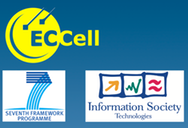This WP aims to establish redox synthetic coupling of redox-active SCP-DNAs to an external localized energy source via electrochemical processes. Photochemistry will be employed as an ancillary option. As redox active SCP-DNA we will further elaborate the chemistry of 3'-5'-disulphides as isosteric backbone replacements of 3'-5' phosphordiesters and of organometallic Ru(bipy) complexes with DNA. Nonenzymatic self-replication experiments will be carried out based on disulphide ligations accompanied by the release of a suitable thiolated lipid or a thiolated polymer constituent. Further studies will address whether disulphide and thus template formation can be linked to the photochemical injection of a radical cation into the double strands on the oxidative Ru-pathway, or, preferably by direct oxidation in an electrochemical microcell. Microelectrochemical techniques ranging from cyclic voltammetry to Scanning Electrochemical Microscopy and AFM will be used in off-chip analyses to characterize and optimize the redox systems.
Electronic activation involves both manipulation by electric fields and electrochemical processes. Direct manipulation by electric fields includes transport, concentration and separation via combinations of electrophoresis and electroosmosis, and will be addressed in WP4. In WP3, for the ECCell metabolism, a programmable electrochemical metabolism is proposed. Two key processes are involved:
a. electrochemical manipulation of processes via pH
b. electronic control of process specific redox chemistry
